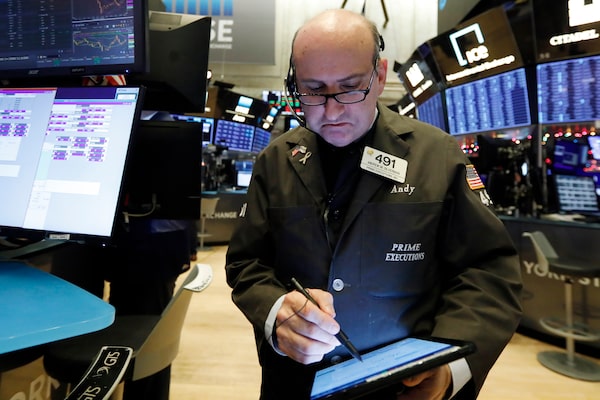
Trader Andrew Silverman works on the floor of the New York Stock Exchange, Wednesday, Dec. 11.Richard Drew/The Associated Press
Wall Street’s main stock indexes ended modestly higher on Wednesday after the U.S. Federal Reserve held interest rates steady and signaled that borrowing costs are likely to remain unchanged indefinitely. The Toronto market slipped slightly.
The U.S. central bank said moderate economic growth and low unemployment are expected to continue through next year’s presidential election.
After cutting rates three times earlier this year, the Fed left its benchmark rate at the target range of between 1.50% and 1.75%, a decision that was widely expected.
“You are looking at a cautiously optimistic Fed,” said Karl Schamotta, chief market strategist at Cambridge Global Payments in Toronto. “The tone that you see through the statement and projections suggest that they believe that they have taken out enough insurance to prevent a downturn.”
The Fed’s move to ease monetary policy this year has supported the rise in stocks to record highs; the S&P 500 has gained 25% so far in 2019.
With the Fed expected to stand pat on rates this time, investors have been more focused on U.S.-China trade relations, including new tariffs on Chinese goods. President Donald Trump has said the new tariffs will go into effect on Dec. 15, but uncertainty remains over whether they will be implemented.
“There was really nothing to take away from the narrative which has taken the stock market higher, which is the Fed has lowered rates three times this year. So we are in a pretty good interest rate environment to hopefully help the growth rate,” said James Ragan, director of wealth management research at D.A. Davidson in Seattle. “The focus will be back on trade here after today.”
Fed policymakers said they would continue monitoring “global developments” in deciding whether interest rates need to change. They also said they would keep an eye on “muted inflation pressures,” a reflection of concern that the pace of price increases has failed to hit the central bank’s target.
Data on Wednesday did show U.S. consumer prices increased solidly in November.
The Dow Jones Industrial Average rose 29.37 points, or 0.11%, to 27,911.09, the S&P 500 gained 9.1 points, or 0.29%, to 3,141.62, and the Nasdaq Composite added 37.87 points, or 0.44%, to 8,654.05.
Most S&P 500 sectors finished positive, with materials and technology leading the way.
In company news, Home Depot Inc shares fell 1.8% as the home improvement chain forecast fiscal 2020 sales below Wall Street expectations. Home Depot shares were the biggest drag on the Dow, keeping the blue chip index’s gain relatively slim.
American Eagle Outfitters Inc shares dropped 6.5% after the apparel retailer forecast holiday-quarter profit and comparable sales below market expectations.
Canada
The S&P/TSX Composite Index closed down 11.09 points, or 0.07 per cent, at 16,939.61. The material sector provided some support, gaining 1.4 per cent, as bullion prices in New York edged up slightly. But crude oil prices fell, sending the energy capped index down 0.67 per cent.
BRP Inc. was a key mover, following the announcement of a $306-million bought deal that didn’t appear to be well received by the market.
Read more: Market movers: Stocks seeing action on Wednesday - and why
Wednesday’s analyst upgrades and downgrades
Reuters, with files from The Globe and Mail